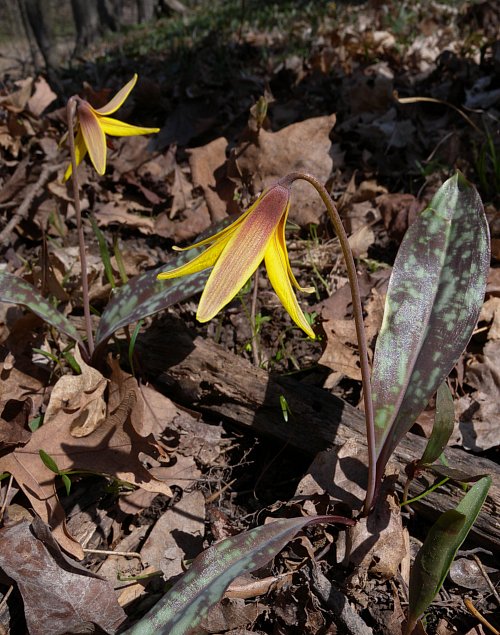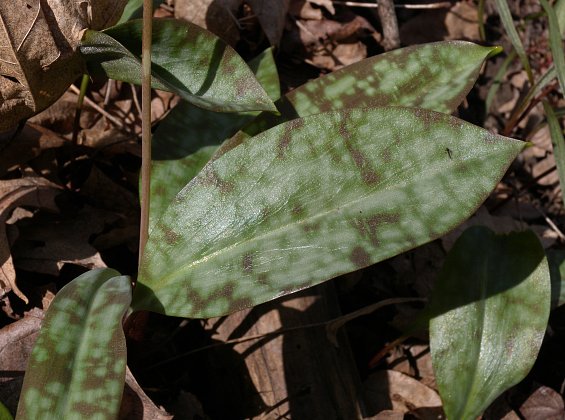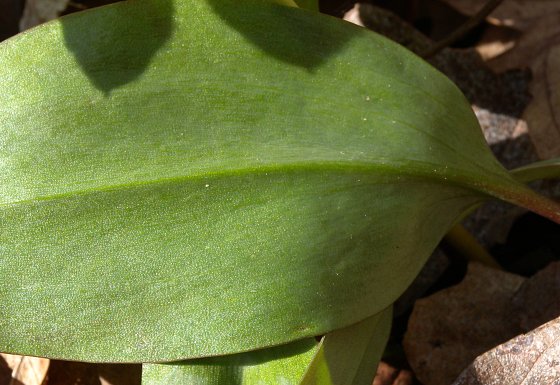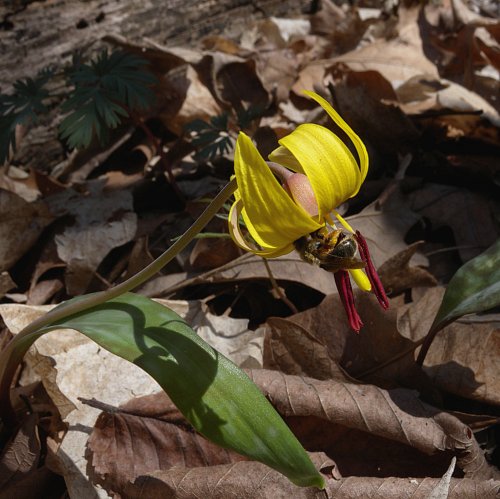
The inflorescence has a long flowering stalk that is terete, glabrous, and light green to pale reddish brown. This stalk is mostly erect or ascending, but it nods downward at its tip where the flower occurs. The nodding flower is ¾-1¼" long, consisting of 6 yellow tepals, 6 stamens, and an ovary with 3 erect stigmata. Initially, the tepals are barely separated from each other, but as the flower matures they become strongly recurved, exposing the reproductive organs. These tepals are narrowly elliptic-lanceolate in shape, and they are often tinted red or reddish brown along their outer sides. The stamens are about ½" long and their anthers are yellow or yellow-brown. The blooming period occurs during mid-spring and lasts about 2 weeks. Afterwards, the flowers are replaced by obovoid seed capsules that are about ½" in length or a little longer. These capsules are glabrous and their apices are truncate to rounded. At maturity, these capsules divide into 3 parts to release their seeds.

The root system consists of a corm with fibrous roots underneath, and 0-3 stolons. The stolons extend below the leaf litter, creating clonal offshoots from the mother plant. As a result, colonies of plants are often formed, consisting largely of immature shoots.
Cultivation: The preference is dappled sunlight to medium shade, more or less mesic conditions, and loamy soil with leaf litter and decaying organic matter. Most growth and development occurs during the spring before the trees fully develop their vernal leaves. This wildflower adapts readily to the shade of various deciduous trees. It takes several years of development (typically about 8 years) before individual plants will flower in a typical woodland setting.

Range & Habitat: The native Yellow Trout Lily is occasional in southern Illinois, while in the rest of the state it is uncommon or absent (see Distribution Map). Outside of southern Illinois, it is largely restricted to the eastern half of the state. Illinois lies toward the western range limit of this plant; it is more common further to the east. Habitats include rich woodlands, wooded bluffs, rocky woodlands, and banks of streams. Yellow Trout Lily is found in deciduous woodlands, where Sugar Maple (Acer saccharum), American Beech (Fagus grandifolia), and other deciduous trees are present.

Faunal Associations: The nectar and pollen of the flowers attract largely bees, including bumblebees, Mason bees, and Andrenid bees. One bee species, Andrena erythronii, is a weak oligolege (specialist pollinator) of Erythronium spp. (Trout Lilies). Like several other woodland wildflowers, the seeds of Yellow Trout Lily are distributed in part by ants, which are attracted to their food appendages. Because the leaves of this plant are relatively small and inconspicuous, they are browsed by White-tailed Deer to only a limited extent. The mottled pattern of the leaves helps to disguise them from such mammalian herbivores as they lack color vision.
Photographic Location: A deciduous woodland at Jim Smith's farm in Vermilion County, Illinois.

Comments: This is the only yellow-flowered Trout Lily (Erythronium) in Illinois, making it easy to identify. The other two species of Trout Lily within the state, Erythronium albidum (White Trout Lily) and Erythronium mesochoreum (Prairie Trout Lily), have either white flowers or bluish white flowers. Both the flowers and foliage of Yellow Trout Lily are quite attractive, although the blooming period is rather short and most plants fail to flower during any given year. In Illinois, Yellow Trout Lily is much less common than White Trout Lily. However, in states further to the east, the reverse is true: Yellow Trout Lily is more common than White Trout Lily.